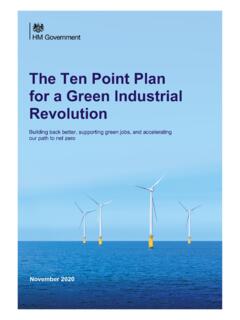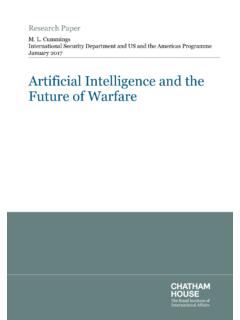Transcription of Quality Infrastructure in 21st Century Africa
1 Quality Infrastructure in 21st Century AfricaQuality Infrastructure in 21st Century Africa PRIORITISING, accelerating AND SCALING UPIN THE CONTEXT OF PIDA (2021-30)This work is published under the responsibility of the Secretary-General of the OECD. The opinions expressed and arguments employed herein do not necessarily reflect the official views of the member countries of the OECD, its Development Centre or of s document, as wel l as an y dat a an d ma p included herein , ar e without prejudice to th e statu s of or sovereignty over any territory, to the delimitation of international frontiers and boundaries and to the name of any territory, city or cite this publication as:OECD/ACET (2020), Quality Infrastructure in 21st Century Africa : Prioritising, accelerating and Scaling up in the Context of Pida (2021-30).
2 Photo credits: Cover design by Aida Buend a (OECD Development Centre) on the basis of an image from OECD/ACET 2020 The use of this work, whether digital or print, is governed by the Terms and Conditions to be found at 3 Quality Infrastructure IN 21ST Century Africa OECD/ACET 2020 Foreword At the 18th International Economic Forum on Africa , at the Organisation for Economic Co-operation and Development (OECD) in October 2018, President Nana Akufo-Addo of Ghana gave our two organisations a challenge. He requested a technical investigation into why African governments are increasingly turning to emerging economies, notably China, for large Infrastructure projects, with the more compact timeframes that their policy banks and contractors offer, compared with Africa s mainstream development partners.
3 This report is a response to that challenge and a result of our work together through a programme of case studies, research and high-level expert discussions, to contribute elucidating this phenomenon. The trend itself was first noticed in the 2009 World Bank Report Building Bridges and in the 2011 AfDB-OECD-ECA-UNDP African Economic Outlook on Africa and its emerging partners . It garnered much attention when the President of China unveiled the Belt and Road Initiative (BRI) in 2013. However, China s engagement in development co-operation with African countries dates back to 1960 and earlier. In 1964, Prime Minister Zhou Enlai announced on a visit to Ghana China s Eight Principles for economic aid and technical assistance. By the 1970s, China had built the Tazara Railway linking Zambia to Tanzania.
4 The case studies in this report (before they were curtailed by the COVID-19 crisis) showed that large Infrastructure projects often take decades to fall into place, in Africa and elsewhere, with political history being a major factor. Our expert discussions ranged across various approaches to Infrastructure development in Africa and underscored the relevance of the duality noted by President Akufo-Addo. On the one hand, there are mainstream development partners and their increasingly elaborate upstream processes for project preparation, with detailed environmental, social and governance requirements, aimed at developing both institutions and Infrastructure . On the other hand, there are other partners, notably China, with readily available financial and corporate structures, and a constellation of actors that can quickly develop different types of Infrastructure projects, emerging from their own ongoing development experience.
5 For China, institutional development is an outcome rather than a starting point, and early Infrastructure investment is necessary to leapfrog the development process further underlining the fundamental difference of the two approaches. However, Chinese actors, and the international community at large, are increasingly recognising the relevance of environmental, social and governance factors, and of local ownership of the development process. Work in the G20 on Quality Infrastructure investment and on addressing debt overhangs in the wake of COVID-19 does promise some underlying convergence of approaches. The African Union (AU) s Agenda 2063, the United Nations (UN) agenda for climate change and the UN Sustainable Development Goals promote this convergence more fundamentally, albeit amidst rising global tensions.
6 The efforts we set in motion after President Akufo-Addo s challenge have nevertheless resulted in a rich body of work on reforming the upstream processes of project development. They confirmed the importance of looking at the whole Infrastructure policy process and placing Infrastructure within a country s overall sustainable development strategy. A common complaint is that it is not finance, but rather the shortage of ready to go , bankable projects and programmes, that is the biggest constraint to Infrastructure development. In this context, mainstream agencies like the World Bank Group are rethinking their conceptual and policy frameworks, and design processes for Infrastructure programmes. 4 Quality Infrastructure IN 21ST Century Africa OECD/ACET 2020 Importantly, this issue has become central to the design of the Programme for Infrastructure Development in Africa (PIDA) 2021-30 proposal, which will be put forward to African Heads of State and Government in early 2021.
7 The challenge we set out to confront has thus led to close collaboration with the African Union and its Development Agency (AUDA-NEPAD). The two recommendations that have emerged from our collaborative work support and extend the PIDA reforms on: i) embedding structure and timeframes into more standardised project preparation processes; and ii) generating a programme for peer learning among Infrastructure professionals and stakeholders across Africa . The AU Agenda 2063 and the African Continental Free Trade Area provide the context for these two lines of action, with their vision to transform Africa s economic geography and human development through integrated regional economic corridors, by leveraging new technology, and by turning the demographic drama of an additional one billion people by 2050 into a demographic bonus.
8 Our two organisations are deeply concerned with transformation and development dynamics in Africa . Individually, our commitment to regional integration and local economic development is long-standing ( Amoako as former Executive Secretary of the UN Economic Commission for Africa [UNECA], and Mario Pezzini who led OECD s extensive work on territorial development). Looking forward, we are eager to support the AU Commission and AUDA in their efforts to provide replicable structured approaches to Infrastructure development in Africa and work with all interest partners and stakeholders to grow the capabilities and energy devoted to achieving this goal. Mario Pezzini Director of the OECD Development Centre and Special Advisor of the OECD Secretary-General on Development Amoako President of the African Center for Economic Transformation 5 Quality Infrastructure IN 21ST Century Africa OECD/ACET 2020 Acknowledgements The report Quality Infrastructure in 21st Century Africa was jointly prepared by the Organisation for Economic Co-operation and Development (OECD) Development Centre (DEV) and the African Center for Economic Transformation (ACET).
9 This report is an outcome document of a joint DEV/ACET project, proposed by Nana Akufo-Addo, President of the Republic of Ghana, to analyse procedures that delay Infrastructure development in Africa and to find ways for accelerating and scaling up, a call expressed at the 18th International Economic Forum on Africa , co-organised by the OECD Development Centre, the African Union and the Agence fran aise de d veloppement, and held in Paris in October 2018. To take this initiative forward, financial and technical support was provided by the German Organisation for International Development (GIZ) on behalf of Germany s Federal Ministry for Economic Co-operation and Development (BMZ), in partnership with the African Union (AU) and the African Union Development Agency/New Partnership for Africa 's Development (AUDA-NEPAD).
10 The research, analysis, interviews and drafting of the report were led by Kaori Miyamoto, Senior Policy Analyst at DEV, and Dan Preston, Clinical Associate Professor of Indiana University. Yumika Yamada, Policy Analyst at DEV, as well as Julian Kullik and Ana Grozdev, interns, also carried out substantive drafting, with support provided by Julia Peppino, Adem Kocaman and Marika Boiron. The project was guided by Richard Carey, Senior Fellow of ACET, and Arthur Minsat, Head of Unit for Africa and Senior Economist at DEV, under the supervision of Amoako, President of ACET, supported by Rob Floyd, Director and Senior Advisor at ACET, and Mario Pezzini, Director of the OECD Development Centre and Special Advisor of the OECD Secretary-General on Development. The report was launched at a High Level Panel event under the aegis of Nana Akufo-Addo, President of the Republic of Ghana on 9 July 2020.















